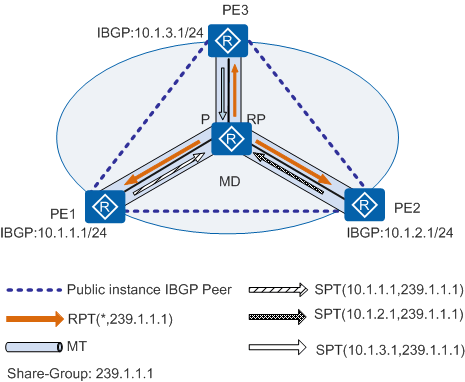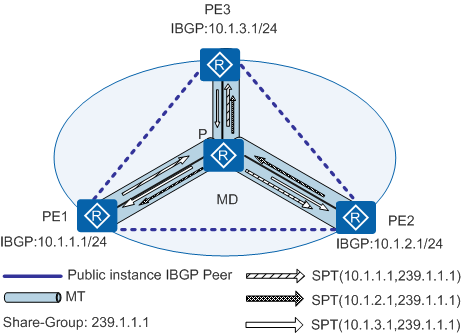Share-MDT Establishment
A Share-MDT uses a Share-Group address. A Share-Group address uniquely identifies a Share-MDT on a VPN. A public network can run either PIM-SM or PIM-DM, and the Share-MDT establishment process differs in the two PIM modes.

- The multicast source address of a Share-MDT (MTI IP address) must be the IP address of the interface used to establish IBGP connections to other PEs. In most cases, the multicast source address of a Share-MDT is the IP address of a loopback interface.
- The multicast group address of a Share-MDT (Share-Group address) must be defined before multicast VPN deployment. An MD must have the same group address on all PE devices, and different MDs must have different group addresses.
Establishing a Share-MDT on a PIM-SM Network
As shown in Figure 1, PIM-SM runs on the public network. The P device functions as the rendezvous point (RP).
With Figure 1 as an example, the process for establishing a Share-MDT is as follows:
PE1 sends a Join message to the RP on the public network through the public network instance. The Join message uses the Share-Group address as the multicast group address. PE devices that receive the Join message create the (*, 239.1.1.1) entry. PE2 and PE3 also send Join messages to the RP. An RPT is established in the MD, with the RP as the root and PE1, PE2, and PE3 as leaves.
PE1 sends a Register message to the RP through the public network instance. In the Register message, the source address is the MTI address and the group address is the Share-Group address. The RP creates the (10.1.1.1, 239.1.1.1) entry after receiving the Register message. PE2 and PE3 also send Register messages to the RP. Three independent SPTs connecting PE devices to the RP are established in the MD.
On the PIM-SM network, an RPT (*, 239.1.1.1) and the three SPTs form a Share-MDT.
Establishing a Share-MDT on a PIM-DM Network
As shown in Figure 2, PIM-DM runs on the public network.
The process for establishing a Share-MDT is as follows:
- PE1 initiates a flood-prune process in the public network instance, using IP address of the MTI (interface used for establishing IBGP peers) as the multicast source address, the Share-Group address as the multicast group address, and PE2 and PE3 as group members.
- PE devices along the path create the (10.1.1.1, 239.1.1.1). An SPT is established, with PE1 as the root, and PE2 and PE3 as leaves. PE2 and PE3 also initiate flood-prune processes, through which two SPTs are established.
On the PIM-DM network, these three independent SPTs form a Share-MDT.

